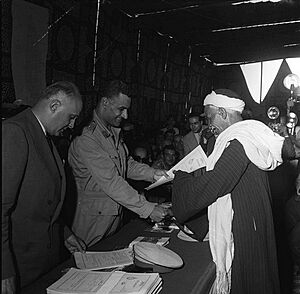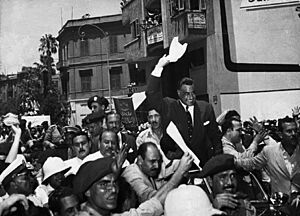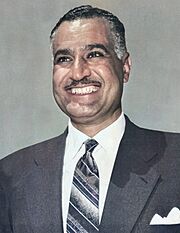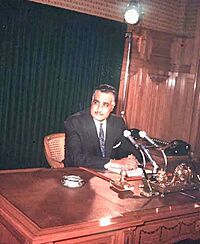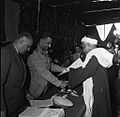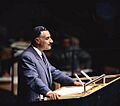History of Egypt under Gamal Abdel Nasser facts for kids
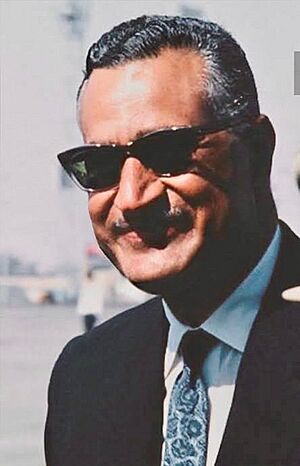
The history of Egypt under Gamal Abdel Nasser tells the story of Egypt from the Egyptian revolution of 1952 until Nasser's death in 1970. Gamal Abdel Nasser was a key leader of this revolution. His time as Egypt's president, from 1956 to 1970, brought many changes. Egypt became more modern and focused on helping its people. Nasser also strongly believed in Arab unity and supporting other developing countries.
His popularity grew hugely after he took control of the Suez Canal Company in 1956. Egypt's success in the Suez Crisis that followed made him a hero. However, the Six-Day War in 1967, where Israel won, greatly hurt his image. During Nasser's rule, life improved for many Egyptians. They had better access to homes, education, jobs, and healthcare. The economy grew with projects like the Aswan High Dam. Egypt also became a leader in culture, with many famous artists and films.
Contents
Egypt Becomes a Republic (1953–1958)
The Egyptian Revolution of 1952
On July 22-26, 1952, a group of army officers called the Free Officers started the Egyptian Revolution of 1952. They were led by Gamal Abdel Nasser and General Muhammad Naguib. They overthrew King Farouk, who was blamed for Egypt's problems. The old royal family was removed without much protest.
After the revolution, the Free Officers took control. On June 18, 1953, Egypt became a republic. Muhammad Naguib was named Egypt's first President. All other political parties were soon banned. A new government party called the "Liberation Rally" was formed.
Nasser Becomes President
Gamal Abdel Nasser became prime minister in February 1954. He led the Egyptian Revolutionary Command Council until he became President of Egypt in 1956. He remained president until he passed away in 1970.
British Troops Leave Egypt
The new Egyptian government wanted British and French troops to leave the Suez Canal area. After much discussion, Nasser signed a treaty on October 19, 1954. This treaty stated that British troops would leave Egypt within 20 months. On June 18, 1956, Nasser proudly raised the Egyptian flag over the Canal Zone. This marked the complete departure of British troops.
New Rules for Egypt
On January 16, 1956, President Nasser announced a new set of rules for the country. This new system gave the president the power to choose and remove government ministers. A new law was also passed on March 3. For the first time in Egyptian history, women were given the right to vote. Nasser was then elected as the second president of the Republic on June 23.
Economy and Society
Land Reform
Before the revolution, a very small number of rich people owned most of Egypt's land. Less than 6% of the population owned over 65% of the land. The Free Officers quickly started land reform on September 11, 1952. A new law limited how much land one person could own. It also set fair rental rates for land and helped farmers form cooperatives.
During Nasser's time, the amount of land used for farming in Egypt grew by almost a third. This was a big achievement for the country.
Economic Growth
Egypt's economy grew very quickly during this period. For almost ten years, it grew by about 9% each year. The amount of money made from manufacturing (making goods in factories) also increased a lot. It went from about 14% of Egypt's total economy in the late 1940s to 35% by the early 1970s.
About 75% of Egypt's total wealth was moved from the rich to the government or to millions of small landowners. This was a huge social change.
Changes for Foreign Residents
Many foreign residents, especially from European and Middle Eastern communities, left Egypt during Nasser's rule. These groups included British, French, Greeks, Italians, Armenians, Maltese, and Jews. They had lived in Egypt for a long time. As Egyptian nationalism grew, these groups, especially the British, French, and Jews, faced difficulties.
Many Jewish people, about 23,000 to 25,000, left Egypt. They often had to sign papers saying they were leaving voluntarily. Their belongings were sometimes taken by the government. Similar actions were taken against British and French citizens.
Foreign Affairs
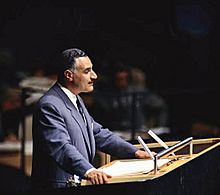
Nasser's decision to take control of the Suez Canal was a huge victory for Egypt. He was seen as a hero in Egypt and across the Arab world. He was praised for standing up to powerful nations. China's leader, Zhou Enlai, even called Nasser "the giant of the Middle East."
Nasser also helped create the Non-Aligned Movement in 1961. This group was made up of "independent nations" that did not side with either the United States or the Soviet Union during the Cold War. Many anti-colonial leaders from Africa came to him for advice and support.
Standing Against the Baghdad Pact
Nasser was a strong critic of the 1955 Baghdad Pact. This was an alliance between Iraq and Turkey, supported by Britain. Nasser believed it was a British attempt to divide Arab countries. When Britain tried to get Jordan to join the pact, Nasser worked to stop it. He used Egyptian radio to speak out against Britain. He also warned the Jordanian government that joining the pact could cause problems for them.
Nasser's efforts worked. Jordan decided not to join the Baghdad Pact. This showed Nasser's smart approach to diplomacy. Jordan later supported Egypt during the Suez Crisis.
The Suez Crisis (Tripartite Aggression)
Why it Happened
Egypt wanted loans from the World Bank to build the Aswan High Dam. An agreement was almost reached with the US and Britain. However, Nasser had also made a deal with the Soviet Union for military help. This angered the United States. So, on July 20, 1956, the US and Britain withdrew their offers to fund the dam.
On July 26, Nasser gave a famous speech. He announced that Egypt was taking control of the Suez Canal Company. He said the money from the canal would be used to build the High Dam. This made Britain and France very angry. They froze Egyptian money and prepared their armies. The USSR then offered to fund the dam project instead.
The Plan
Britain and France secretly made a plan with Israel. The plan was to take back the Suez Canal, remove Nasser from power, and restore European and Jewish property. Israel would attack Egypt first. Then, British and French forces would invade the canal area. They would claim they were protecting the canal, as allowed by an old treaty. Their goal was to then invade Cairo and overthrow Nasser.
The Invasion
On October 29, Israeli troops invaded the Sinai Peninsula. As planned, British and French troops attacked the Canal Zone on October 31. They used air strikes, naval attacks, and paratroopers. Large forces were on their way to occupy the canal and move into Cairo.
However, things did not go as smoothly as planned. Britain and France relied heavily on American support for their economies. The United States, the United Nations, and even American oil companies put huge pressure on Britain and France to stop. The US government started an oil embargo against them. This caused panic in the British government.
The British government decided to stop its operations on November 7. The US made it clear that it did not support European colonialism. As a result, British and French control over the Suez Canal ended. All British and French banks and companies in Egypt were taken over by the Egyptian government. This event showed the end of European colonial power in the region.
Union with Syria
On February 22, 1958, Egypt and Syria joined together. They formed the United Arab Republic (UAR). The old Egyptian constitution was replaced. A new flag was created with three horizontal bars of red, white, and black, with two stars. However, this union did not last long. Syria left the union in 1962.
After Syria left, Nasser set up a new political group called the Arab Socialist Union (ASU). This group was meant to include representatives from farmers, workers, and professionals. Half of the seats in the ASU were set aside for farmers and workers.
Yemen War
In 1962, Egypt got involved in a civil war in Yemen. Egypt supported the new government that had overthrown the old ruler. This war was very costly for Egypt, both financially and militarily. It also caused tension with Saudi Arabia, which supported the other side.
The 1967 War (Six-Day War)
From May 14, 1967, Nasser moved many Egyptian troops into the Sinai Peninsula, near the Israeli border. Under pressure from other Arab nations, Nasser asked the UN Secretary General to remove the UN peacekeeping forces from the border. Egypt also closed the Straits of Tiran to Israeli ships. Israel had said that closing these straits would be an act of war. On May 30, King Hussein of Jordan visited Cairo and signed a defense agreement with Egypt.
On June 5, Israeli forces launched a surprise attack. They severely damaged Egyptian airfields and most of the Egyptian air force on the ground. Israel quickly occupied the Sinai Peninsula and the Gaza Strip. Jordan and Syria joined the war on Egypt's side. Israel then also occupied the Jordanian West Bank and the Syrian Golan Heights. Egypt, Jordan, and Syria accepted a UN ceasefire on June 7-10.
Egypt's defeat in the 1967 War led Nasser to resign on June 9. However, huge public demonstrations of support made him change his mind.
Society Under Nasser
In the early 1950s, when the monarchy fell, most Egyptians were poor. Less than half of all primary school children attended school, and most of them were boys. Nearly 75% of adults over ten years old could not read or write. Over 90% of all women were illiterate.
Nasser's policies changed this. Land reform, taking over major businesses, and a big increase in university education helped many people. Millions of Egyptians who were once poor joined the middle class. Doctors, engineers, teachers, lawyers, and journalists became a large part of Egypt's growing middle class under Nasser.
See also
- History of Egypt under Anwar Sadat
- Egyptian revolution of 2011
- Egyptian Revolutionary Command Council
- History of modern Egypt
- List of modern conflicts in the Middle East
Images for kids
-
Gamal Abdel Nasser in 1966
-
Nasser addressing the United Nations General Assembly, 1960


